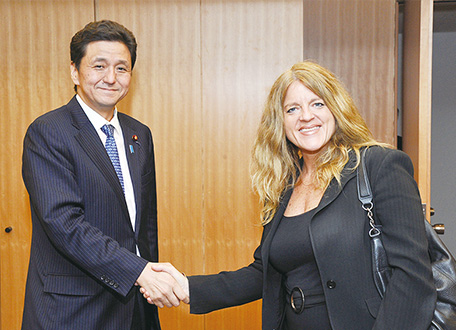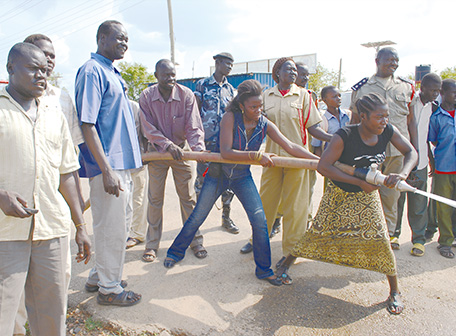Japan's Official Development Assistance White Paper 2013
(5) Sudan and South Sudan
After the Second Sudanese Civil War lasted over 20 years, in July 2011, South Sudan gained independence by seceding from Sudan. The African Union (AU) mediated negotiations on many issues between Sudan and South Sudan prior to South Sudan’s independence. In September 2012, the governments of both countries agreed on issues such as oil and security measures in border areas. However, some of the agreed issues remain unimplemented, and both countries have not reached agreements on belonging of the Abyei region (Note 18) to which both countries still lay claim and have problems in the disputed area. As of July 2013, Sudan and South Sudan are continuing discussions for coexisting peacefully.
<Japan’s Efforts>
Peacebuilding is one of the important agendas of Japan’s diplomacy towards Africa. In particular, stability in Sudan and South Sudan is directly related to the stability of the whole of Africa, so supporting the consolidation of peace in those two countries is a particularly important point on the agenda in Africa. With this understanding, Japan has disbursed over $1.1 billion to Sudan and South Sudan since 2005. Japan continues to support the consolidation of peace through disarmament, demobilization and reintegration (DDR) for former soldiers and lend assistance in fields dealing with basic human needs (BHN) so that the people of the two nations actually feel that peace has been established and do not revert to civil war. Specifically, Japan provides support focused on meeting BHN and maintaining a food production base mainly in the war-torn regions of Sudan. To South Sudan, in addition to the aforementioned support, Japan’s assistance focuses on development of infrastructure and governance.
In addition, Japan has dispatched an engineering unit from the Japan Self-Defense Force to work on the United Nations Mission in the Republic of South Sudan (UNMISS) and is implementing projects that have a connection to the engineering unit’s activities so that Japan can put forth an integrated effort for stability and nation-building in South Sudan.
(As of September 2013)

In October 2013, Parliamentary Senior Vice-Minister for Foreign Affairs Nobuo Kishi had a meeting with Ms. Hilde Johnson, Special Representative of the Secretary-General and Head of the United Nations Mission in the Republic of South Sudan (UNMISS).
Note 18: The Abyei region is located on the north-south border in Sudan. Since it was one of the most hard-fought battlefields during the North-South civil war and has rich oil reserves, both countries claim sovereignty over this region.
●South Sudan
The Project for Enhancement of Operation and Management Capacity of Inland Waterway in Southern Sudan
Technical Cooperation Project (March 2011 - Ongoing)
Following the end of the civil war in 2005, South Sudan became independent in 2011. Since then, reconstruction of the country and the revitalization of economic activity have made progress but the lasting effects of civil war have caused significant delays in the construction of infrastructure. Transportation infrastructure is one area that suffers most significantly. Many arterial roads in South Sudan are still unsealed and are often impassable during the wet season. Of all the transportation routes in South Sudan, waterway traffic on the White Nile River plays the most important role but required urgent action due to insufficient port facilities and poor management of Juba Port.
Beginning with improvement works on a section of the pier at Juba Port in 2006, Japan has been providing supports for port and harbor projects in South Sudan. This Technical Cooperation Project began in 2011 with Japanese experts providing training to 29 South Sudanese in South Sudan along with providing training in Japan and other countries including Sudan, Kenya and Cambodia. This training will equip South Sudan with the capacity to conduct safe and efficient load handling, maintenance and management of Juba Port.
Japan is currently assisting improvements of pier facilities, load handling, load storage and load management facilities and the procurement of equipment through the provision of Grant Aid. Furthermore, Japan aims to increase the cargo handling capacity and ensure its safety and efficiency.
(As of August 2013)

A comprehensive fire drill was conducted in partnership with a state fire department, as part of the management of ports and harbors. Participants are extinguishing a mock fire using an actual fire truck and hose. (Photo: JICA)
